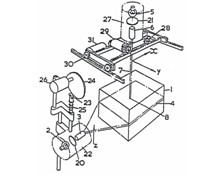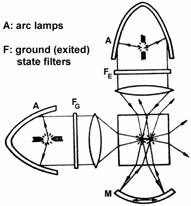
|


|

|
Either scroll down to view the complete Hall of Fame or choose the type:
The Felix3D Team has spent a lot of time researching the history of volumetric imaging. Nevertheless we ask you to help us by completing this Hall of Fame, so please send us descriptions and pictures of yet unknown (or here only preliminary stated) experimental setups or prototypes. We would be glad for any new descriptions and if possible one photo of the display and one of the researching team.
swept volume techniques
a) flat surface display
b) curved surface display
c) oscillating screen display
static volume techniques
d) solid state display
e) gaseous state display
other techniques
f) miscellaneous display type
Solid static volume displays


|
 Stereoscopic projection technique
Stereoscopic projection technique
E. Luzy and C. Dupuis
1912
|
|
|
|
|


|
 Stylus in gelatin material
Stylus in gelatin material
Chrysler
1960
|
Besides, early approaches from the beginning of the 1960s proposed the mechanical insertion, support, and translation of objects or particles in a volume. E.g. a stylus which can write in three colors was suspended in a tank of transparent gelatin. The servo-driven stylus moves through the gelatin, leaving a colored trace. This concept is limited to low data rates but provides history or track, since the unit itself handles integration and storage. Actual stereo-lithography processes for rapid prototyping purposes may be seen as a modern application of this technology.
|
|
|
|


|
 Display system using rare-earth doped fluoride crystals
Display system using rare-earth doped fluoride crystals
M. R. Brown, G. Waters
1964
|
In 1964 M. R. Brown et al. filed the first patent for a 3D display based upon two photon upconversion processes (Figure 7). He proposes several fluoride crystals containing between 0.05 and 25% of trivalent thulium, erbium or holmium ions as useable. In his apparatus voxels appear in the region of intersection between a light beam (movable in X and Y direction) and a fan-shaped light plane (movable in Z direction). Thereby the angle stays nearly constant, so that the shape of voxels will be essentially invariant with position.
|
|
|
|


|
 Three-Dimensional Visual Display Systems
Three-Dimensional Visual Display Systems
Brown, Michael Richard; Waters, Geoffrey Sherwood;
1969
|
|
|
|
|


|
 Display system based on simultaneous absorption of two photons
Display system based on simultaneous absorption of two photons
M.A. Dugay, J.A.Giordmaine, P.M. Rentzepis
1970
|
In 1967 Dugay et al. described a 3D display using the simultaneous absorption of two-photon. Especially their voxel activation strategy is notable. Two collinear lasers cross the display volume in different directions. The first laser encodes the voxel information, which means, whether a voxel is to be activated or not. The second laser interrogates this information and executes them.
M.A. Dugay, J.A. Giordmaine, P.M. Rentzepis, ?Display system using two-photon fluorescent materials?, U.S. Patent 3,541,542, 1970.
|
|
|
|


|
 Display System Using Two-Photon Fluorescent Materials
Display System Using Two-Photon Fluorescent Materials
Duguay, Michel A.; Heights, Berkeley; Giordmaine, Joseph A.; Rentzepis Peter M.
1970
|
|
|
|
|


|
 Voxel generation in Er3+ doped CaF2 crystals
Voxel generation in Er3+ doped CaF2 crystals
J.D. Lewis, C.M. Verber, R.B. McGhee
1971
|
In 1971 Lewis et al. developed a 3D display based upon two-frequency, two-step upconversion. The display volume is described by a 2-cm CaF2 crystal cube doped with the rare earth element erbium. Two orthogonally arranged filtered xenon lamps are the excitation source. By pumping the erbium with 1540 nm and 830 nm a green output (540 nm) is emitted. As the second beam is reflected through the crystal cube, it crosses the first beam twice and thereby two voxels appear. The spots have a size of 2 mm in diameter and a measured output of 2?10-8 W radiated isotropically, which means that they are clearly visible in a dimly lit room.
|
|
|
|


|
 Method and Apparatus for Generating Three-Dimensional Patterns
Method and Apparatus for Generating Three-Dimensional Patterns
Adamson, Arthur W.
1971
|
|
|
|
|


|
 Computer-Controlled Three-Dimensional Pattern Generator
Computer-Controlled Three-Dimensional Pattern Generator
Lewis, Jordan D.; Veber, Carl M.; McGhee, Robert B.
1974
|
|
|
|
|


|
 Optical information processing system with color center crystal
Optical information processing system with color center crystal
Carson, Arthur N.
1976
|
An optical information storage and retrieved system is presented wherein intersecting beams of coherent light at least one of which is information bearing are used to change the state of color centers in a crystal to effect information storage. Information is retrieved or read out by determining the state of color centers in the crystal.
|
|
|
|


|
 Three dimensional image generating apparatus having a phosphor chamber
Three dimensional image generating apparatus having a phosphor chamber
Downing, Elizabeth A.; Torres, Bernardo
1989
|
Three dimensional television viewing apparatus having an image chamber which produces images that can be viewed from a plurality of directions. An imaging phosphor is distributed in a three dimensional chamber. A pair of energy beams are directed by a pair of scanning systems inside the chamber to an intersection where visible light is released from the imaging phosphor. The point of intersection of the two beams is moved inside the chamber to produce a visible three dimensional image.
|
|
|
|


|
 Voxel addressed by optical fiber
Voxel addressed by optical fiber
D. MacFarlane, G. R. Schultz, P. D. Higley, J. Meyer
1994
|
D. L. MacFarlane built a quite different true 3D display in 1994. The display has a volume of 300 cm³ and is able to emit 11*11*5 monochrome voxels. Transparent optical fibers address each single voxel within several layers of planar glass microsheets . The fibers are made of an UV-curved optical resin doped with an organic dye. In order to avoid Fresnel reflections, MacFarlane filled the gaps between the voxels with an index-matching liquid medium. Light excitation sources like nitrogen pumped dye lasers or Hg lamps were tested successfully.
A mayor problem of this display is to find glasses, fibers and filling mediums with suiting indexes of reflections. However, a mayor advantage is its ability to switch all voxels at the same time, as the fibers are pumped via several flat arrays of liquid crystals outside the display.
|
|
|
|


|
 Field-sequential projection on stacked polymer dispersed liquid crystal displays
Field-sequential projection on stacked polymer dispersed liquid crystal displays
E. Paek
1996
|
|
|
|
|


|
 One-beam pumping of Er3+-doped ZBLAN glasses
One-beam pumping of Er3+-doped ZBLAN glasses
T. Honda, T. Doumuki, A.Akella, L. Galambos, and L. Hesselink
1998
|
In 1998 Honda investigated the quantum efficiency for one frequency two step upconversion in 0.2 mol% Erbium doped ZBLAN glass. This alternative excitation method uses one focused laser beam at a wavelength of 979 nm, which matches both first and second energy level. Figure 11 shows the IR fluorescence, which is caused by one step excitation along the laser beam?s path, and the green emission, which appears only at the beam?s waist, the point with the largest intensity.
TEST
|
|
|
|


|
 Layered LC -based 3D display using one light source
Layered LC -based 3D display using one light source
M. S. Leung, N. A. Ives, G. Eng
1998
|
|
|
|
|


|
 Layered LC -based 3D display with several light sources
Layered LC -based 3D display with several light sources
R. S. Gold, J. E. Freeman
1998
|
|
|
|
|


|
 Principle demonstration of 3D volumetric display achieved by PrYb co-doped materials
Principle demonstration of 3D volumetric display achieved by PrYb co-doped materials
X. Chen
2000
|
|
|
|
|


|
 Principle demonstration of 3D volumetric display achieved by PrYb co-doped materials
Principle demonstration of 3D volumetric display achieved by PrYb co-doped materials
Xiaobo Chen, et. al.
2000
|
|
|
|
|


|
 Dispersed crystallite up-conversion displays
Dispersed crystallite up-conversion displays
M. Bass, et.al.
2001
|
Dispersed crystallite up-conversion displays
|
|
|
|


|
 Volumetric display based on upconversion phosphors
Volumetric display based on upconversion phosphors
Jianying Cao, et. al.
2005
|
|
|
|
|
|
|
|















